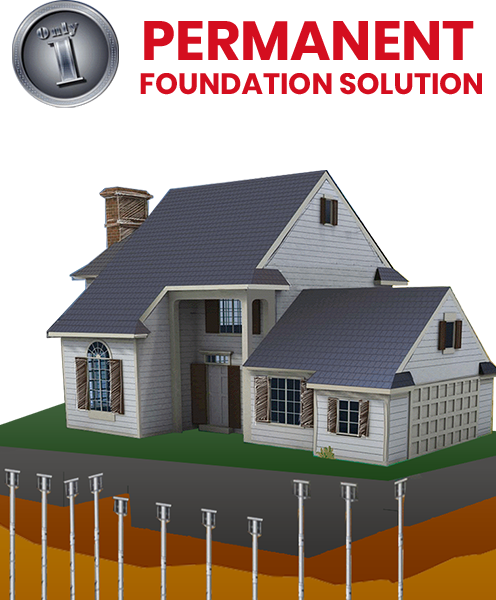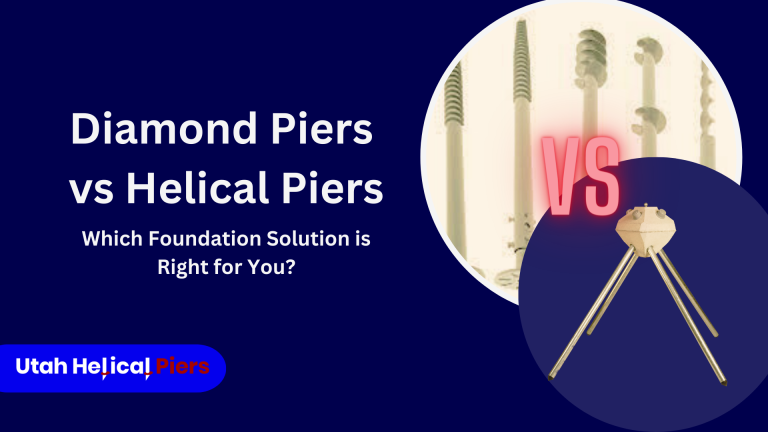What are Helical Piers: A Comprehensive Guide

If you’re building a new structure or renovating an existing one, you may have heard about helical piers. These innovative foundation solutions offer many advantages over traditional concrete footings.
In this article, we’ll explore everything you need to know about helical piers, including their cost, installation, DIY options, and applications for decks and new construction.
What are Helical Piers?
Helical piers, also known as helical piles or screw piles, are deep foundation systems used to support structures. They consist of steel shafts with helical plates welded to them. The helical plates act as anchors, holding the piers in place and providing support for the structure above.
How Much Do Helical Piers Cost To Install
The cost of helical piers depends on various factors, including the size and weight of the structure, soil conditions, and the number of piers needed. On average, helical piers cost between $150 and $250 per foot of depth. A typical residential project may require piers ranging from 10 to 30 feet in depth, with costs ranging from $1,500 to $7,500 per pier.
Here is a table that provides a more detailed breakdown of the cost of helical piers:
| Serial No | Factors | Costs |
|---|---|---|
| 1 | Size and weight of the structure | The larger and heavier the structure, the more piers will be needed and the deeper they will need to be, which will increase the cost. |
| 2 | Soil conditions | If the soil at the site is poor, it may require deeper piers, which will increase the cost. |
| 3 | Number of piers needed | The more piers that are needed, the higher the cost. Depth of the piers |
| 4 | Depth of the piers | The deeper the piers need to be, the higher the cost. |
| 5 | Cost of labor and materials in the area | The cost of labor and materials can vary depending on the location. |
Sure, here is some more information on the cost of helical piers:
The cost of helical piers varies depending on a number of factors, including:
- The size and weight of the structure being supported
- The soil conditions at the site
- The number of piers needed
- The depth of the piers
- The cost of labor and materials in the area
In general, helical piers cost between $150 and $250 per foot of depth. A typical residential project may require piers ranging from 10 to 30 feet in depth, with costs ranging from $1,500 to $7,500 per pier.
So here are some additional things to keep in mind when considering the cost of helical piers:
- Helical piers are a permanent solution, so they should only be used if the foundation problem is also permanent.
- Helical piers can be more expensive than other foundation repair methods, such as push piers.
- Helical piers can be noisy and disruptive during installation, so it is important to consider the impact on your neighbors.
Overall, helical piers can be a cost-effective and effective way to repair a foundation that is sinking or settling. However, it is important to weigh the costs and benefits carefully before making a decision.
How Do Helical Piers Work
Helical piers are a type of foundation support that is used to stabilize structures that are built on weak or unstable soil. They are made of a steel shaft with helical blades that are attached to the bottom. The helical blades are screwed into the ground until they reach a stable layer of soil. The weight of the structure is then transferred to the ground through the helical blades.
The helical blades create a secure connection with the ground by gripping the soil. The blades are designed to have a large surface area, which helps to increase the friction between the blades and the soil. This friction prevents the pier from moving in the ground, even under heavy loads.
The load of the structure is transferred to the ground through the helical blades in a process called “bearing capacity.” The bearing capacity of soil is the maximum amount of weight that the soil can support before it starts to fail. The helical blades are designed to reach a depth where the soil has a high bearing capacity. This ensures that the structure will be supported even under heavy loads.
Helical piers are a versatile foundation support that can be used in a variety of soil conditions. They are a good choice for structures that are built on weak or unstable soil, such as those that are built on fill dirt or on slopes. Helical piers are also a good choice for structures that are located in areas that are prone to earthquakes or other natural disasters.
Helical Piers vs. Concrete Footings
Helical piers offer many advantages over traditional concrete footings. They can be installed in a fraction of the time, with less excavation and disruption to the site. They’re also more resistant to shifting and settling, providing a more stable foundation for the structure above. Additionally, helical piers can be installed in areas with poor soil conditions or high water tables, where traditional footings may not be feasible.
Here is a table comparing the advantages and disadvantages of helical piers and concrete footings:
| Feature | Helical Piers | Concrete Footings |
|---|---|---|
| Installation time | Quicker | Slower |
| Excavation required | Less | More |
| Site disruption | Less | More |
| Resistance to shifting and settling | More | Less |
| Ability to be installed in poor soil conditions | Yes | No |
| Ability to be installed in areas with high water tables | Yes | No |
| Cost | More | Less |
| Durability | Long-lasting | Long-lasting |
| Maintenance | Low-maintenance | Low-maintenance |
DIY Helical Pier Installation
While it’s possible to install helical piers yourself, it’s generally not recommended. Helical pier installation requires specialized equipment and expertise. Without proper training and equipment, you risk damaging the piers, the structure, or even yourself.
Helical Piers for Decks
Helical piers are an excellent choice for deck construction. They provide a stable, long-lasting foundation that can withstand the weight of the deck and its occupants. They also require less excavation and can be installed in areas with poor soil conditions or high water tables.
Helical Piers for New Construction
Helical piers are becoming increasingly popular for new construction projects. They offer many advantages over traditional footings, including faster installation, less disruption to the site, and better resistance to shifting and settling. They’re also more environmentally friendly, as they require less concrete and excavation.
Advantages of Helical Piers
Disadvantages of Helical Piers
- Higher cost than traditional footing
- Requires specialized equipment and expertise
- May not be suitable for all soil conditions
- May require regular maintenance
When to Consider Helical Piers
Helical piers may be a good choice for your project if you are experiencing any of the following foundation problems:
- Foundation settlement: This is when the foundation of your home or building sinks or settles over time. This can be caused by a variety of factors, including poor soil conditions, heavy rains, or earthquakes. Foundation settlement can cause cracks in your foundation, walls, and floors.
- Foundation tilting: This is when the foundation of your home or building tilts or leans to one side. This can be caused by the same factors that cause foundation settlement, as well as by tree roots, underground utilities, or uneven soil compaction. Foundation tilting can cause cracks in your foundation, walls, and floors, and can also make your home or building unsafe to live in.
- Foundation cracks: Cracks in your foundation can be a sign of a more serious foundation problem. If you see cracks in your foundation, it is important to have a foundation inspection to determine the cause of the cracks and to recommend a repair solution.
Helical piers can be used to stabilize a foundation that is sinking, settling, or tilting. They can also be used to repair cracks in your foundation. Helical piers are a permanent solution, so they can provide peace of mind knowing that your foundation is stable and secure.
Here are some other reasons why you might want to consider helical piers:
- You are building in an area with poor soil conditions.
- You are building in an area with a high water table.
- You are building a large or heavy structure.
- You want a quick and easy foundation repair solution.
- You want a permanent foundation repair solution.
If you are considering helical piers for your project, it is important to get quotes from several different contractors to compare prices and services. You should also make sure that the contractor you choose is licensed and insured.
Helical piers can be a good choice for a variety of foundation problems. If you are experiencing any of the foundation problems listed above, helical piers may be a good option for your project.
Helical Pier Installation Process
The installation process for helical piers involves several steps:
- Site evaluation: A soil analysis is conducted to determine soil type, bearing capacity, and other site-specific factors.
- Pier design: The number, size, and depth of the piers are determined based on the weight of the structure and the soil conditions.
- Pier installation: The piers are installed using specialized equipment, such as a hydraulic drill motor, which rotates the pier into the ground.
- Pier load testing: The piers are load tested to ensure that they can support the weight of the structure.
- Pier connection: The piers are connected to the foundation using brackets or other connectors.
How Deep Are Helical Piers Installed?
The depth of helical piers varies depending on the weight of the structure and the soil conditions. In general, residential helical piers are installed to a depth of 10 to 30 feet.
Helical Pier Load Capacity
The load capacity of helical piers depends on several factors, including the size and weight of the structure, the soil conditions, and the depth of the piers. Load capacity can be determined through load testing, which involves applying a specific weight or force to the piers and measuring their deflection.
How Long Do Helical Piers Last?
Helical piers are designed to last for many years, with a lifespan of up to 100 years or more. However, their lifespan may be affected by factors such as soil conditions, exposure to moisture or chemicals, and regular maintenance.
Choosing a Helical Pier Contractor
When choosing a helical pier contractor, it’s important to consider factors such as experience, reputation, and certifications. Look for a contractor who has experience with helical piers and a good track record of successful installations. Additionally, make sure the contractor is licensed and insured, and ask for references from past clients.
Conclusion
Helical piers offer many advantages over traditional footings, including faster installation, better resistance to shifting and settling, and suitability for poor soil conditions or high water tables. However, they do require specialized equipment and expertise and may be more expensive than traditional footings. If you’re considering helical piers for your project, be sure to choose a reputable contractor with experience in helical pier installation.

